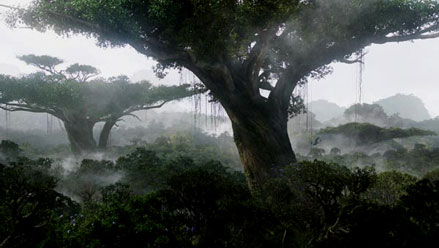A Place Called Clouds
“God’s Cloud over the people forms a Great Booth, within which they live. That Cloud over them is like the glorious canopy of a leafy tree, and thus the reproduction of such an arboreal canopy is a symbol of God’s Cloud.”
An important thread of God’s methodology is His process of bringing us from slavery to Sabbath, from childhood to maturity. It begins with Creation and ends with Glorification.
The Lord speaks the Word from His glory cloud—like the Light created on Day 1—and a stagnant history begins to move forward once again. At the end of the process the Lord returns in His cloud, but it is now made of something even better. The Lord’s robe is no longer a covering of Angels but a covering of redeemed, glorified Men.
In the Tabernacle, the housebuilding process begins with the Ark as “Light” and ends with God’s Cloud—the Shekinah—resting upon it. In the Feasts, it begins with the regular Sabbath as the Creation week and ends with the Feast of Tabernacles, the greater rest.
If you are a regular reader here, or have read Totus Christus, you may remember that the pattern of Feasts is used as a common literary structure. Vines, vineyards, branches and leaves are images often employed at this step. (I noticed that even Mary Karr used this at the end of one of the poems I quoted last week).
But this final feast is misnamed. These “Tabernacles” are not tents at all. The word is literally either “booths” or “clouds.” James Jordan writes:
The Feast of Ingathering in the seventh month of the Sinaitic calendar is also called the Feast of Sukkoth, of Booths, also called Feast of Tabernacles. I have usually called it by that last phrase, and it is the most common today; but there is a problem: A tabernacle is a tent, and tents are precisely what are not in view here.
The booths are prescribed in Leviticus 23:40-42, “Now on the first day you shall take for yourselves the growth of beautiful trees – palm branches and boughs of leafy trees and willows of the brook – and you shall rejoice before Yahweh your God for seven days. . . . You shall dwell in booths for seven days; all the native-born in Israel shall dwell in booths.” An example of obedience to this command is found in Nehemiah 8:15, “Go out to the hills and bring olive branches, and oil-tree branches, and myrtle branches, and palm branches, and branches of leafy trees, to make booths, as it is written.”
These are not tents. They are shelters or lean-tos, made of leafy branches. After a week, such shelters would be wearing thin as the leaves decayed.
This seems an odd command, and it becomes odder when we read the reason for it: “So that your generations may know that I had the sons of Israel live in booths when I brought them out from the land of Egypt” (Lev. 23:43).
What is odd about this rationale is that it seems certain that the Israelites did not live in leafy booths when they came out of Egypt. Rubenstein comments: “First, sukkot are generally not found in the desert. They are built in fields for the protection of watchmen, workers, or animals, and constructed from the products of the field – leaves, branches, reeds, foliage, wood, and hay. Where would the Israelites have found such materials in the desert wasteland? Desert travelers stay in tents, not booths.” To which I may add, where would they have found enough foliage for booths for 600,000 men and their families?
Rubenstein continues: “Second, outside of this lone verse in Leviticus, the Bible never claims that the Israelites stayed in booths. There are several descriptions of the camp of the Israelites in the desert, but not one pictures the tribes dwelling in sukkot. Tents are occasionally mentioned, but never booths. Why does Leviticus 23:43 suddenly assume that the Israelites dwelled in sukkot, while the books of Exodus, Numbers, and Deuteronomy know nothing about it?” (See Jeffrey L. Rubenstein, “The Symbolism of the Sukkah,” Judaism 43 [1994], pp. 371ff.)
The answer of the rabbis to this problem, which Rubenstein accepts, begins with noticing that right after leaving Egypt, the Israelites dwelt at a place called Sukkoth. Sukkoth was, in fact, the first place the people went after leaving Egypt: “Now the sons of Israel journeyed from Rameses to Sukkoth, about 600,000 men on foot, aside from children” (Ex. 12:37).
It seems, then, that the Feast of Sukkoth (Booths) memorialized the dwelling of the people at Sukkoth – but why? The rabbis suggest further that “Sukkoth” might not be a place name at all, but a description of an environment in which the people dwelled. And what was that environment? It was an environment of clouds.
This seems to me exactly correct, and the burden of this essay is to unfold the correctness of this suggestion, and show its meaning and fulfillment.
Booths pictures our final home. The Father’s house has many rooms. I recommend reading the rest of Jordan’s essay here.


























